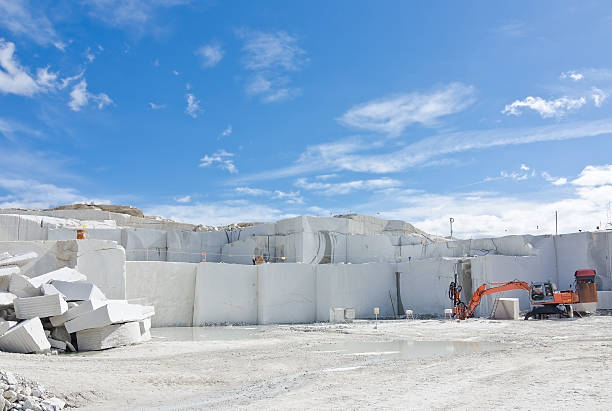Discovering Granite Quarries in South Africa Sector: From Quarry to Work of art
Discovering Granite Quarries in South Africa Sector: From Quarry to Work of art
Blog Article
Introducing the Mysteries of Granite Quarrying: Where Toughness and Beauty Meet
The globe of granite quarrying is a world where the raw strength of nature converges with human creativity to develop structures that stand the test of time with an air of sophistication. From the midsts of quarries to the meticulous polishing in workshops, the procedure of transforming granite into architectural marvels is an intricate dancing of practice and innovation. As we peer into the depths of this old craft, we start to reveal the surprise complexities that shape the extremely significance of our constructed setting.
The Beginnings of Granite Quarrying
In the annals of architectural history, the origins of granite quarrying are shrouded in a tapestry of ancient craftsmanship and geological marvels. Dating back to ancient Egypt and Mesopotamia, the extraction of granite from quarries marked the beginning of a journey that would eventually result in the development of a few of the world's most renowned structures.
Granite quarrying's roots can be traced to the proficient craftsmens that acknowledged the stone's toughness and visual charm. With a combination of primitive tools and sheer decision, these very early quarry workers discovered granite blocks that would become the foundation of human beings.
As human beings advanced, so did the strategies of quarrying granite. The Romans, renowned for their design prowess, developed sophisticated techniques for extracting granite to construct monoliths, holy places, and roads that stood the test of time.
The heritage of these old quarrying methods continues to form modern-day style, with granite continuing to be an icon of stamina and beauty in construction projects around the world. (granite quarries in south africa)
Tools of the Quarrying Profession
The advancement of granite quarrying methods from ancient human beings to contemporary times highlights the vital role played by the devices of the quarrying trade in shaping the sector's methods. In old times, quarrying tools were simple, frequently containing blades, hammers, and wedges made from materials like bronze or iron. These tools called for considerable workforce and time to essence granite obstructs from quarries.

Furthermore, the introduction of pneumatic devices and high-powered equipment has actually significantly reduced the physical labor required in quarrying operations, enhancing worker safety and performance. As the quarrying sector remains to introduce, the devices of the profession stay at the leading edge of driving development and shaping the future of granite extraction.
Removing Blocks of Granite
Making use of accuracy machinery and advanced methods, the removal of granite blocks from quarries has come to be an innovative procedure in the contemporary check it out quarrying market. The initial action includes determining the location and dimension of the granite down payment Get More Info to establish one of the most effective extraction approach. When an appropriate site is picked, the removal process starts with the boring of holes for the positioning of dynamites. Regulated blasting techniques are after that utilized to break apart the granite right into manageable areas.

Polishing and Finishing Methods
To accomplish a perfect surface area on granite blocks, knowledgeable craftsmens employ a series of precise sprucing up and completing strategies. After the initial removal and shaping procedures, the granite blocks undertake a detailed sprucing up stage to improve their all-natural appeal and sturdiness. One common technique used in brightening granite is diamond abrasion, where industrial rubies are used to grind and polish the rock to a smooth surface. This procedure not only develops a lustrous surface area but likewise ensures harmony in color and texture across the granite block.
In addition to sprucing up, ending up techniques are applied to additional improve the granite's appearance. These techniques might include flaming, refining, or cleaning, each offering one-of-a-kind textures and helpful hints surfaces to fit various visual preferences. Flaming, for instance, includes subjecting the granite surface area to high temperature levels to create a rough, textured finish, ideal for exterior applications where slip-resistance is crucial. Honing, on the other hand, provides a matte surface that is smooth to the touch, perfect for indoor countertops and floor covering. By meticulously selecting and using these polishing and finishing techniques, artisans can transform raw granite blocks into beautiful pieces that showcase both strength and beauty.

Ecological Effect and Sustainability
With the expanding focus on ecological consciousness in the market, granite quarrying practices are increasingly looked at for their impact on all-natural sources and lasting sustainability. Additionally, the transportation of granite from quarries to processing facilities produces carbon exhausts, further contributing to environmental degradation.
To mitigate these influences and guarantee sustainability in granite quarrying, market stakeholders are embracing different actions. Applying advanced technologies to reduce energy consumption and water usage, reclaiming quarried land for ecological remediation, and promoting responsible sourcing practices are some strategies being utilized. Moreover, accreditations such as the Forest Stewardship Council (FSC) and the Leadership in Energy and Environmental Design (LEED) aid customers recognize eco pleasant granite products.
Verdict
In final thought, granite quarrying is a process that calls for specialized tools and techniques to remove blocks of granite and polish them to a high degree of surface. While the ecological effect of quarrying can be significant, initiatives are being made to improve sustainability techniques in the market. Generally, granite quarrying is a delicate equilibrium between harnessing the stamina and elegance of this all-natural stone while lessening its impact on the setting.
Report this page